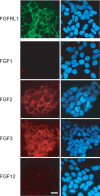The FGFRL1 receptor is shed from cell membranes, binds fibroblast growth factors (FGFs), and antagonizes FGF signaling in Xenopus embryos
- PMID: 19920134
- PMCID: PMC2804375
- DOI: 10.1074/jbc.M109.058248
The FGFRL1 receptor is shed from cell membranes, binds fibroblast growth factors (FGFs), and antagonizes FGF signaling in Xenopus embryos
Abstract
FGFRL1 (fibroblast growth factor receptor like 1) is the fifth and most recently discovered member of the fibroblast growth factor receptor (FGFR) family. With up to 50% amino acid similarity, its extracellular domain closely resembles that of the four conventional FGFRs. Its intracellular domain, however, lacks the split tyrosine kinase domain needed for FGF-mediated signal transduction. During embryogenesis of the mouse, FGFRL1 is essential for the development of parts of the skeleton, the diaphragm muscle, the heart, and the metanephric kidney. Since its discovery, it has been hypothesized that FGFRL1 might act as a decoy receptor for FGF ligands. Here we present several lines of evidence that support this notion. We demonstrate that the FGFRL1 ectodomain is shed from the cell membrane of differentiating C2C12 myoblasts and from HEK293 cells by an as yet unidentified protease, which cuts the receptor in the membrane-proximal region. As determined by ligand dot blot analysis, cell-based binding assays, and surface plasmon resonance analysis, the soluble FGFRL1 ectodomain as well as the membrane-bound receptor are capable of binding to some FGF ligands with high affinity, including FGF2, FGF3, FGF4, FGF8, FGF10, and FGF22. We furthermore show that ectopic expression of FGFRL1 in Xenopus embryos antagonizes FGFR signaling during early development. Taken together, our data provide strong evidence that FGFRL1 is indeed a decoy receptor for FGFs.
Figures







Similar articles
-
Dissecting the Interaction of FGF8 with Receptor FGFRL1.Biomolecules. 2020 Oct 1;10(10):1399. doi: 10.3390/biom10101399. Biomolecules. 2020. PMID: 33019532 Free PMC article.
-
Biology of FGFRL1, the fifth fibroblast growth factor receptor.Cell Mol Life Sci. 2011 Mar;68(6):951-64. doi: 10.1007/s00018-010-0576-3. Epub 2010 Nov 16. Cell Mol Life Sci. 2011. PMID: 21080029 Free PMC article. Review.
-
Targeted disruption of the intracellular domain of receptor FgfrL1 in mice.PLoS One. 2014 Aug 15;9(8):e105210. doi: 10.1371/journal.pone.0105210. eCollection 2014. PLoS One. 2014. PMID: 25126760 Free PMC article.
-
Characterization of FGFRL1, a novel fibroblast growth factor (FGF) receptor preferentially expressed in skeletal tissues.J Biol Chem. 2003 Sep 5;278(36):33857-65. doi: 10.1074/jbc.M300281200. Epub 2003 Jun 17. J Biol Chem. 2003. PMID: 12813049
-
Role of FGFRL1 and other FGF signaling proteins in early kidney development.Cell Mol Life Sci. 2013 Jul;70(14):2505-18. doi: 10.1007/s00018-012-1189-9. Epub 2012 Oct 31. Cell Mol Life Sci. 2013. PMID: 23112089 Free PMC article. Review.
Cited by
-
Dissecting the Interaction of FGF8 with Receptor FGFRL1.Biomolecules. 2020 Oct 1;10(10):1399. doi: 10.3390/biom10101399. Biomolecules. 2020. PMID: 33019532 Free PMC article.
-
Src acts with WNT/FGFRL signaling to pattern the planarian anteroposterior axis.Development. 2022 Apr 1;149(7):dev200125. doi: 10.1242/dev.200125. Epub 2022 Mar 30. Development. 2022. PMID: 35297964 Free PMC article.
-
FGFRL1: Structure, Molecular Function, and Involvement in Human Disease.Curr Issues Mol Biol. 2025 Apr 17;47(4):286. doi: 10.3390/cimb47040286. Curr Issues Mol Biol. 2025. PMID: 40699684 Free PMC article. Review.
-
Extending the family table: Insights from beyond vertebrates into the regulation of embryonic development by FGFs.Birth Defects Res C Embryo Today. 2010 Sep;90(3):214-27. doi: 10.1002/bdrc.20182. Birth Defects Res C Embryo Today. 2010. PMID: 20860061 Free PMC article. Review.
-
Evidence that the novel receptor FGFRL1 signals indirectly via FGFR1.Int J Mol Med. 2013 Nov;32(5):983-8. doi: 10.3892/ijmm.2013.1484. Epub 2013 Sep 10. Int J Mol Med. 2013. PMID: 24026051 Free PMC article.
References
-
- Itoh N., Ornitz D. M. (2004) Trends Genet. 20, 563–569 - PubMed
-
- Itoh N., Ornitz D. M. (2008) Dev. Dyn 237, 18–27 - PubMed
-
- Wiedemann M., Trueb B. (2000) Genomics 69, 275–279 - PubMed
-
- Sleeman M., Fraser J., McDonald M., Yuan S., White D., Grandison P., Kumble K., Watson J. D., Murison J. G. (2001) Gene 271, 171–182 - PubMed
Publication types
MeSH terms
Substances
LinkOut - more resources
Full Text Sources
Molecular Biology Databases
Research Materials

